Bayer Leverkusen made a surprising move by naming Xabi Alonso as their new manager. Alonso had accomplished much more than the typical footballer could during his playing career. The midfielder was the beating heart of every squad that he played for.
The Bundesliga often provides opportunities for young managers to advance, which is why Thomas Tuchel, Julian Nagelsmann, and Jürgen Klopp have gone on to flourish on the biggest stage via this pathway. They were provided with the opportunity to develop their style in Germany’s top flight.
Given that Leverkusen is one of the best teams in Germany, it is a significant undertaking. The German team has suffered one of their worst seasons ever, however. Leverkusen was second-to-last after 8 games. Only one game was won by Gerardo Seoane’s team during this stretch.
In this tactical analysis, we will look at the tactics used by Xabi Alonso in his one month at Bayer Leverkusen before going into the World Cup break. We will also analyse his key players in addition to statistics.
About
Playing under the world’s best like Rafael Benítez at Liverpool, José Mourinho at Real Madrid, and Pep Guardiola at Bayern Munich must have influenced Alonso’s choice to manage a club.
He started his coaching career with Real Madrid’s under-14 squad and went on to go unbeaten the whole season in charge. But he would get his first important experience of senior coaching with Real Sociedad, the club where he began playing football. When Alonso joined Real Sociedad B, the squad was seventh in Segunda Division B.
Although it was a difficult undertaking, the Spaniard managed to get his side promoted to Segunda Division after just one season. People likened it to a certain Pep Guardiola, who wowed the Barcelona B team. However, after being promoted, the squad faltered, finishing 20th in the standings and being relegated. As a result, Real Sociedad confirmed Alonso’s departure.
On the other hand, Leverkusen has a gigantic team of adolescents with endless potential. However, the injury to their great forward Florian Wirtz has cost them dearly. Since March, the adolescent has been on the bench.
Xabi Alonso played in a variety of tactical systems, most of which prioritised possession. His technique has been completely interwoven into his playing style. Alonso’s status as an exceptional midfielder in the world of football will provide him with a significant edge in his managerial career.
Formations
Since taking over, Alonso has favoured a 3-4-3 shape. To discover the optimum combination, many managers tend to adopt this formation. But based on what we can observe, Alonso seems to value this above everything else. He has used the formation in roughly eight of the 10 games.
It’s interesting to consider that he had used a 4-2-3-1 formation in the Champions League matches against Porto and Atletico Madrid. The formation’s objective would be to penalise attacking teams. They lost and drew with them, so it didn’t seem like a success.
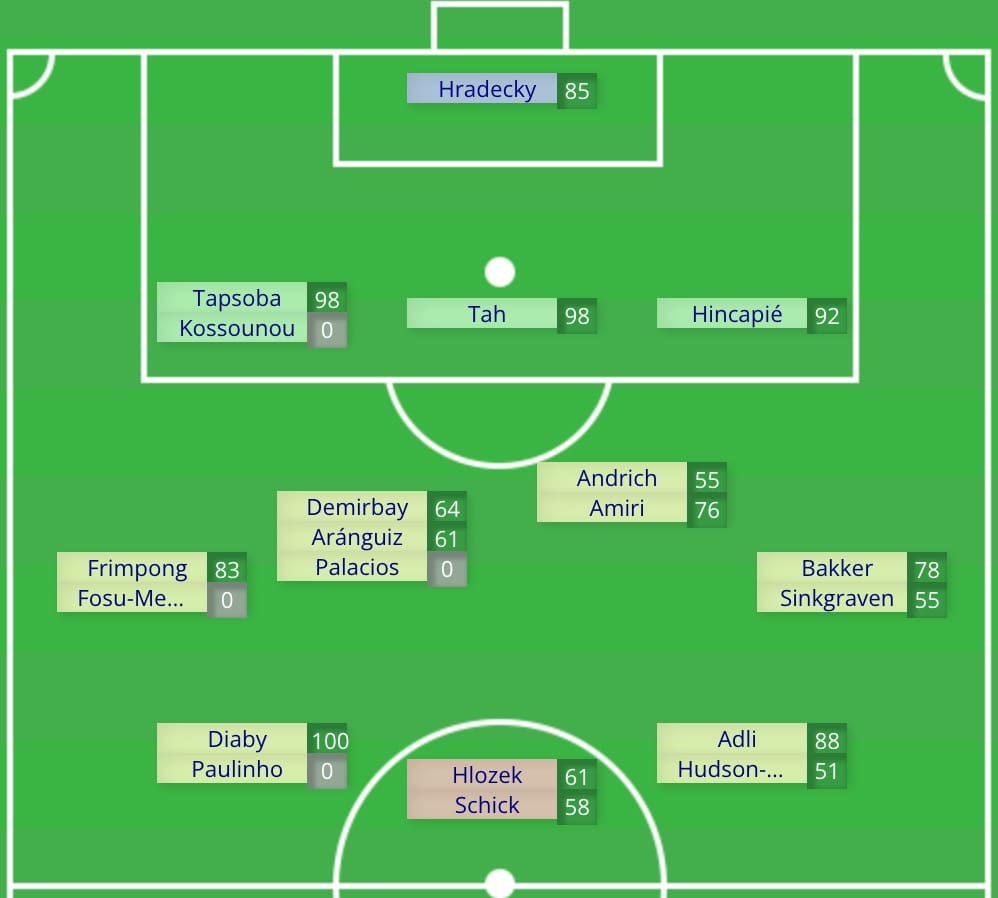
An interesting aspect is that the right central midfielder position has been thoroughly examined. Robert Andrich, who was usually present, filled the left-centre midfielder position. Alonso loved his playing style, which helped him grow as a ball-winning midfielder in the centre. A player like Alonso was required to combine with him in the centre.
Charles Aránguiz was handed the first opportunity, starting three games in a row. He chose Andrisch and Kerem Demirbay for the remainder of his games after playing Aránguiz with Demirbay. Demirbay seems to be the right man for the job.
Exequiel Palacios was added to the mix in the last few games and seems to be working thus far. The outcomes and formations Alonso used in each of the 10 games are shown below.
3-4-3 against Schalke 4-0
4-2-3-1 against Porto 0-3
3-4-2-1 against Eintracht Frankfurt 1-5
3-4-3 against Wolfsburg 2-2
4-3-1-2 against Atletico Madrid 2-2
3-4-3 against RB Leipzig 0-2
3-4-3 against Club Brugge 0-0
3-4-3 against Union Berlin 5-0
3-4-3 against Koln 2-1
3-4-3 against Stuttgart 2-0
Because of its compactness and the dynamism it provides, he preferred this formation. Before the World Cup, Alonso began his run from Schalke through Stuttgart, showing that he was confident in the team and his preferred structure.
Lineups
Lukáš Hrádecký has been Alonso’s consistent player. His performances were much better than those of other ‘keepers. He was enabled in becoming the right fit for Alonso by Hrádecký’s passing. He boasts a phenomenal 98% short-pass accuracy, which is why Alonso chooses him as the constant. Although he has only maintained four clean sheets in total, this seems to be the explanation.
Thanks to the three centre-backs, he has found it easier to adapt to life in Germany. Alonso preferred Jonathan Tah in the middle, surrounded by two young guns. A crucial part of the squad has been played by Edmond Tapsoba. Piero Hincapié and Odilon Kossounou have also played an important role in the defence.
Depending on the pivots, Tah and Tapsoba would periodically swap places. Piero Hincapié and Odilon Kossounou are the 20 and 21-year-old defenders who have rapidly developed through the stages.
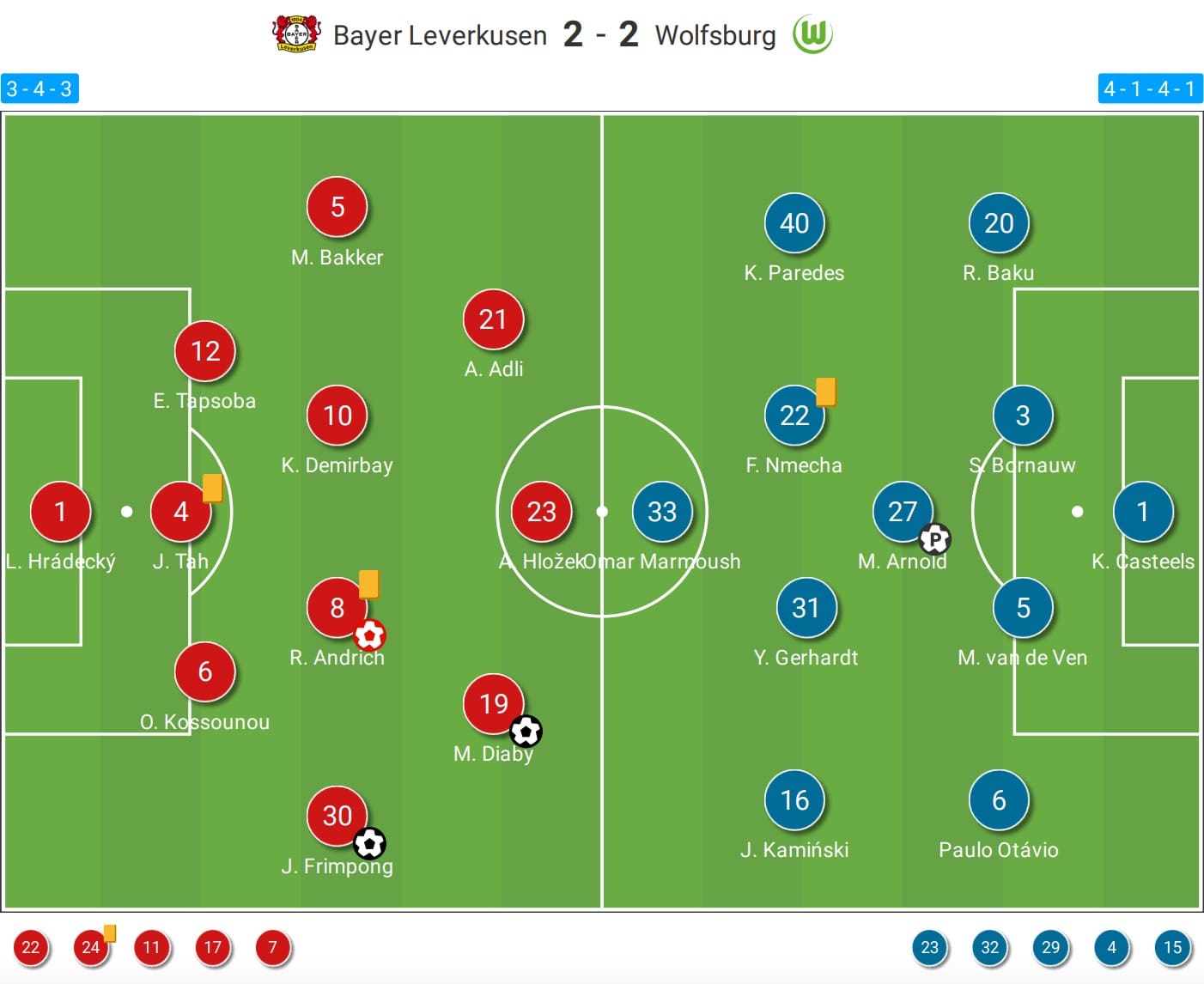
As wingbacks who can play in a variety of positions, Jeremie Frimpong and Mitchel Bakker were the pillars in transitions. Both of them are very young and provide a lot of energy to the attacking phase. The players that seem to be monopolising the centre are Andrich, Demirbay, and Palacios. To establish a rhythm in the middle, Alonso switches between the three.
A three-man attack in the front is led by Moussa Diaby, Amine Adli, and Adam Hložek. Callum Hudson-Odoi has provided the club with additional flair and depth in the attacking phase after joining on a season-long loan from Chelsea.
Patrik Schick would occasionally feature instead of Hložek for a change. Brazilian player Paulinho, 22, came off the bench to score in Alonso’s first game. Despite a strong start, he has been rarely featured for the remainder of the games due to fierce competition in the front.
Attack
To revitalize BayArena, his appointment has been an essential change. Alonso has a quick team at his disposal thanks to Diaby, Adli, Bakker, Frimpong, Hudson-Odoi, and the injured Wirtz.
Alonso’s men are indeed keen on counter-attacks. When they lose possession of the ball, they begin to press, making a 3-4-3 configuration more plausible. Quick attacks contributed significantly to the number of opportunities generated and shots taken.
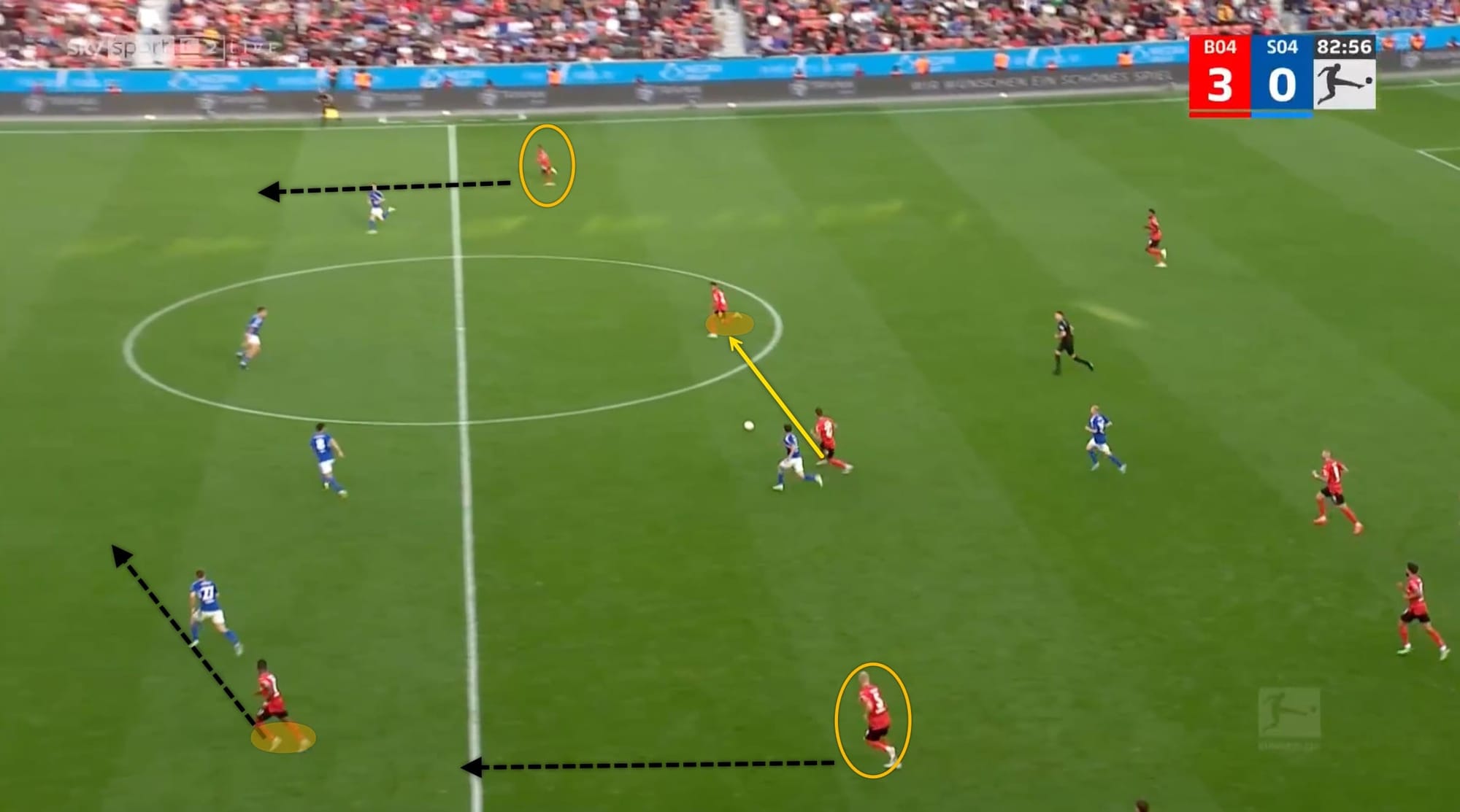
The above picture shows how they counterattack, with the midfielders assisting one another to make rapid passes. The wing-backs are more aggressive in this formation for sure. We see Frimpong and Bakker advancing simultaneously to stretch Schalke’s defensive line. This creates spaces amongst the defenders while also stretching the defence.

Positional attacks are more effective during a mid-block. In the picture above versus Union Berlin, Andrich prioritises supporting the defenders while Demirbay decides to move wide to open up Frimpong’s position. The team’s capability is significantly decided by the behaviour of the pivots. Alonso has experience playing in one of those positions, so he is aware of the kind of guy who could make it happen.
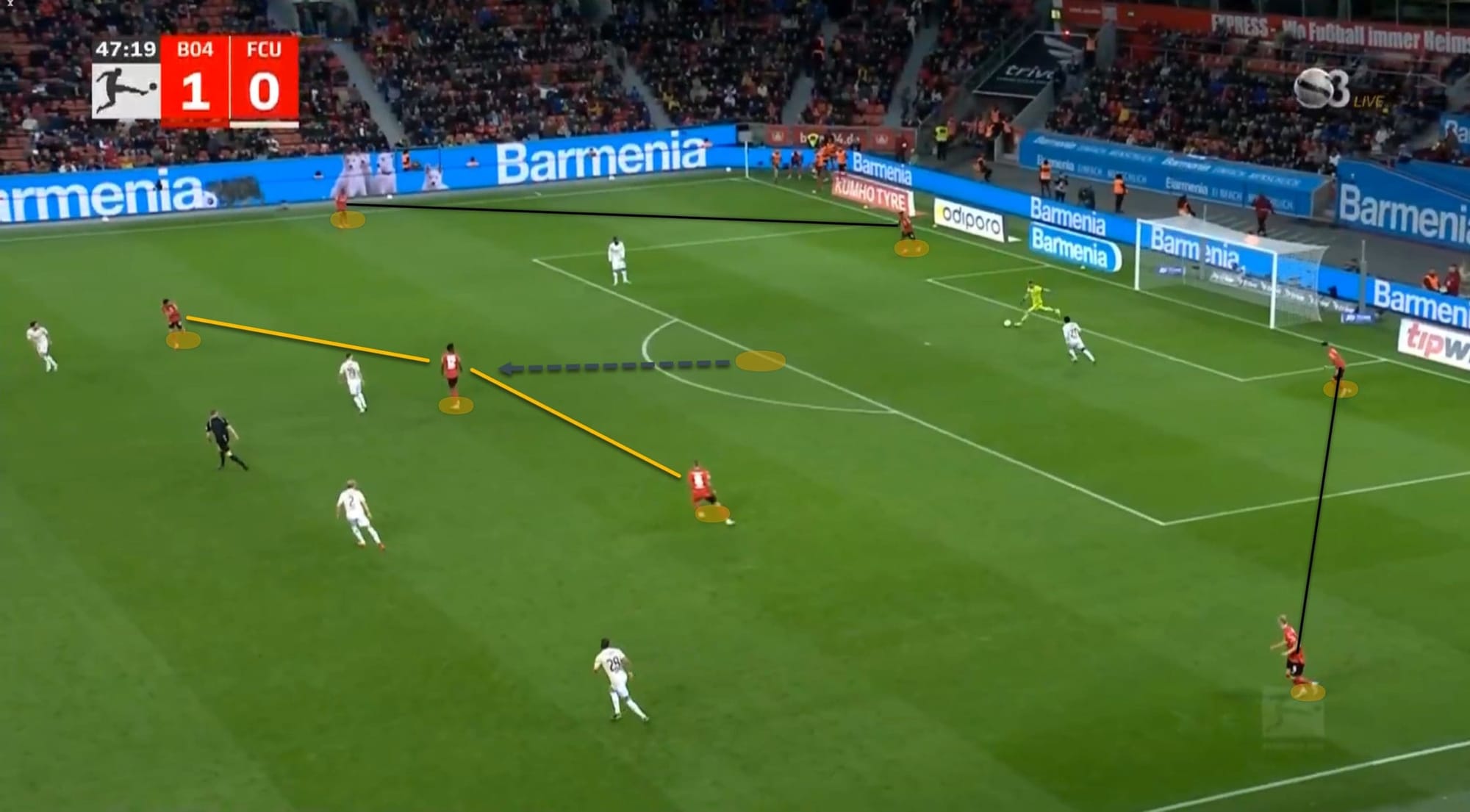
As they play from the back, their back three splits into a back two with the central defender moving forward to the defensive midfield zone, as shown in the illustration above. It is a passing option for both due to the wing-back’s position right next to the sideline. They are given the width and compactness they need to build up.
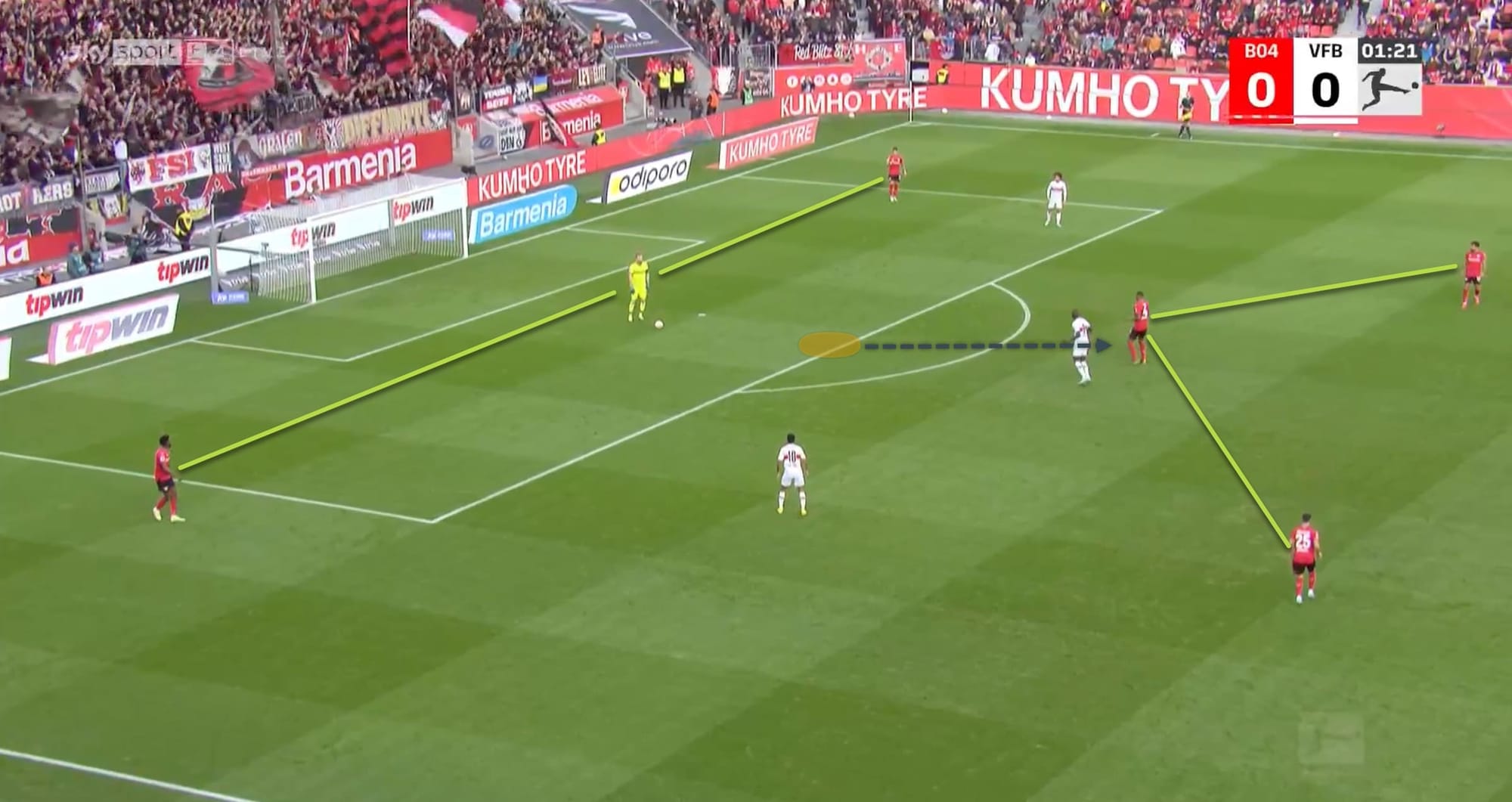
To make building up as natural as possible, whoever is to play as the middle defender in a back three, must be in a position like this. Demirbay is positioned lower than Palacios to create a triangle in another circumstance when Tah plays in the centre with Tapsoba and Hincapié as wide centre-backs. The illustrative picture is shown above.
Hložek is a natural striker who drops deep to hold the ball till his teammates move to a better position. Alonso has used him quite in a way he’s strong in. Hložek deploys as a false 9 player to provide Adli who makes a run to outpace his opponent. This could be the same situation for Diaby, Hudson-Odoi and whoever plays in that position.
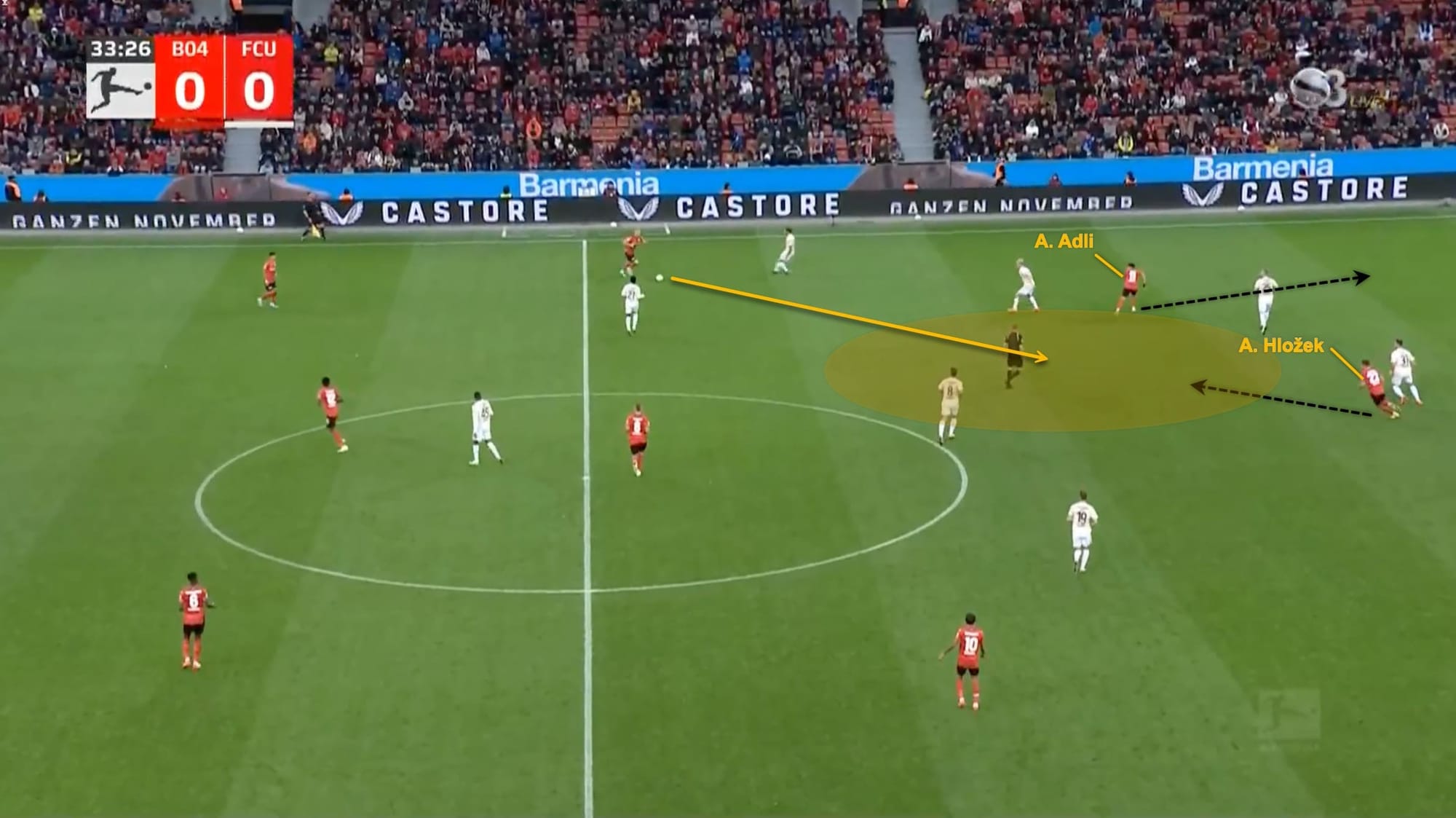
The above picture is a situation that demonstrates this. It looks like a planned move which has been intently practised in the training. This is more threatening when both the players, in this case, Hložek and Adli, have the connection to time the run and pass.
Defence
He had just been working for Leverkusen for 24 days when he faced Leipzig in his sixth game. To everyone’s surprise, Alonso chose Timothy Fosu-Mensah and Daley Sinkgraven over Bakker and Frimpong to start at fullback. They were far older than both of the players. Finally taken out of the game were Fosu-Mensah and Sinkgraven in the 54th and 65th minutes, respectively. Alonso made it clear that he was looking for ways to increase the depth of the team.
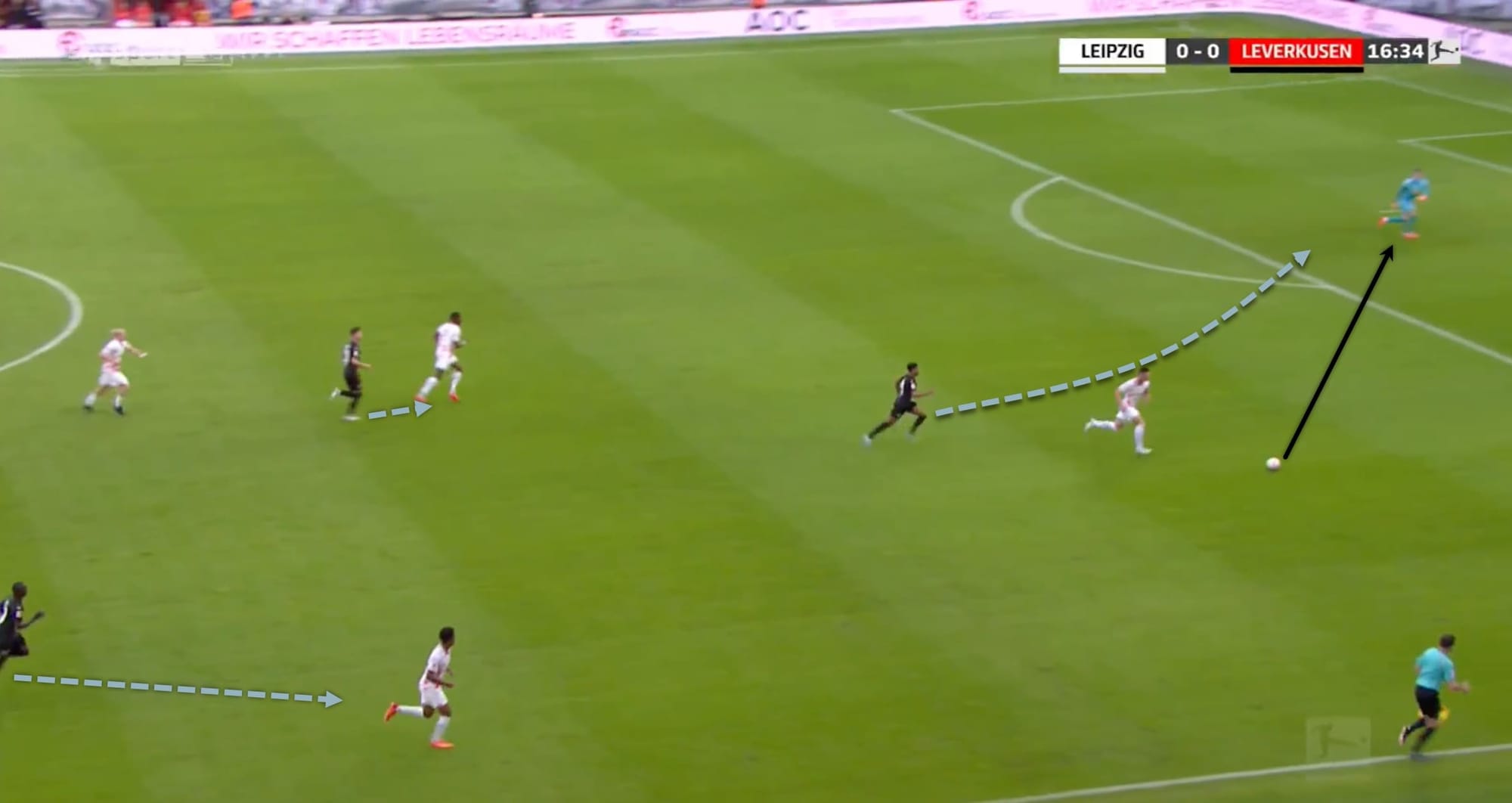
One of the instances against Leipzig as shown in the above image shows Adli rushing to put pressure on the defender and goalie who were being pursued can be seen as the press is initiated. When Adli began to accelerate, Diaby and Schick were alarmed to be quick in marking players.
Alonso’s team played Frankfurt in his third game with an aggressive approach, but they did not succumb to a 5-1 defeat. Leverkusen received four yellow cards, including two for Hincapie, while Frankfurt did not get a single card. Before the red card, Frankfurt scored three goals in rapid succession, and Alonso was compelled to make a defensive substitute by removing Diaby. In a few instances, incidents like this gave the squad the prediction of defeat.
Alonso experimented with the whole team rotating players by making two replacements before the interval, which worked out well when Demirbay came on and helped Hincapie score. However, the unit disintegrated, and Alonso must have drawn a lesson from his men’s combative behaviour.
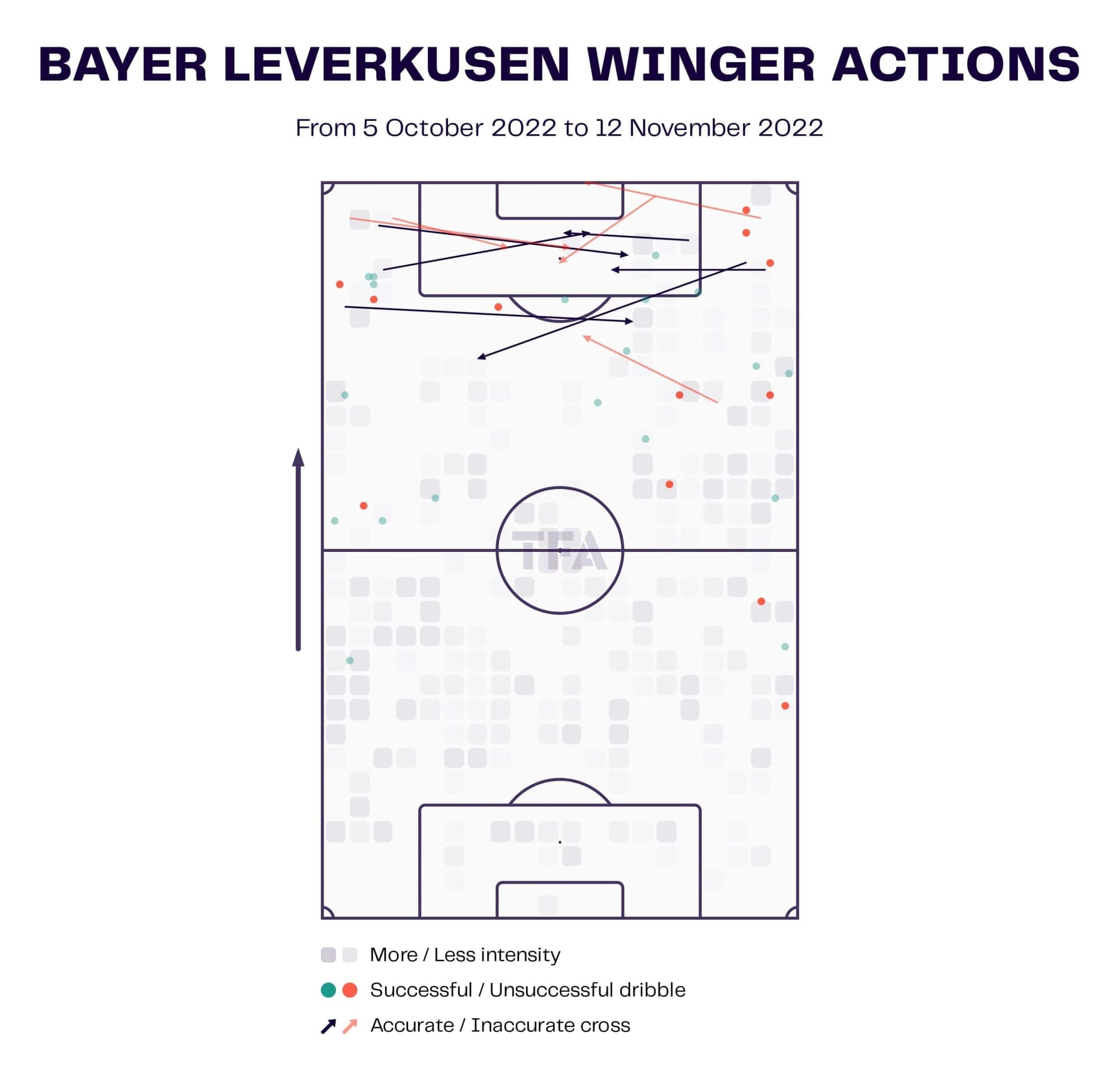
Even though there are quite a few unsuccessful dribbles in the image above, the structure setup allows the midfielders to recover the ball as soon as possible. The counter-pressing has been the key as the structure allows them to crowd and overload at one side.
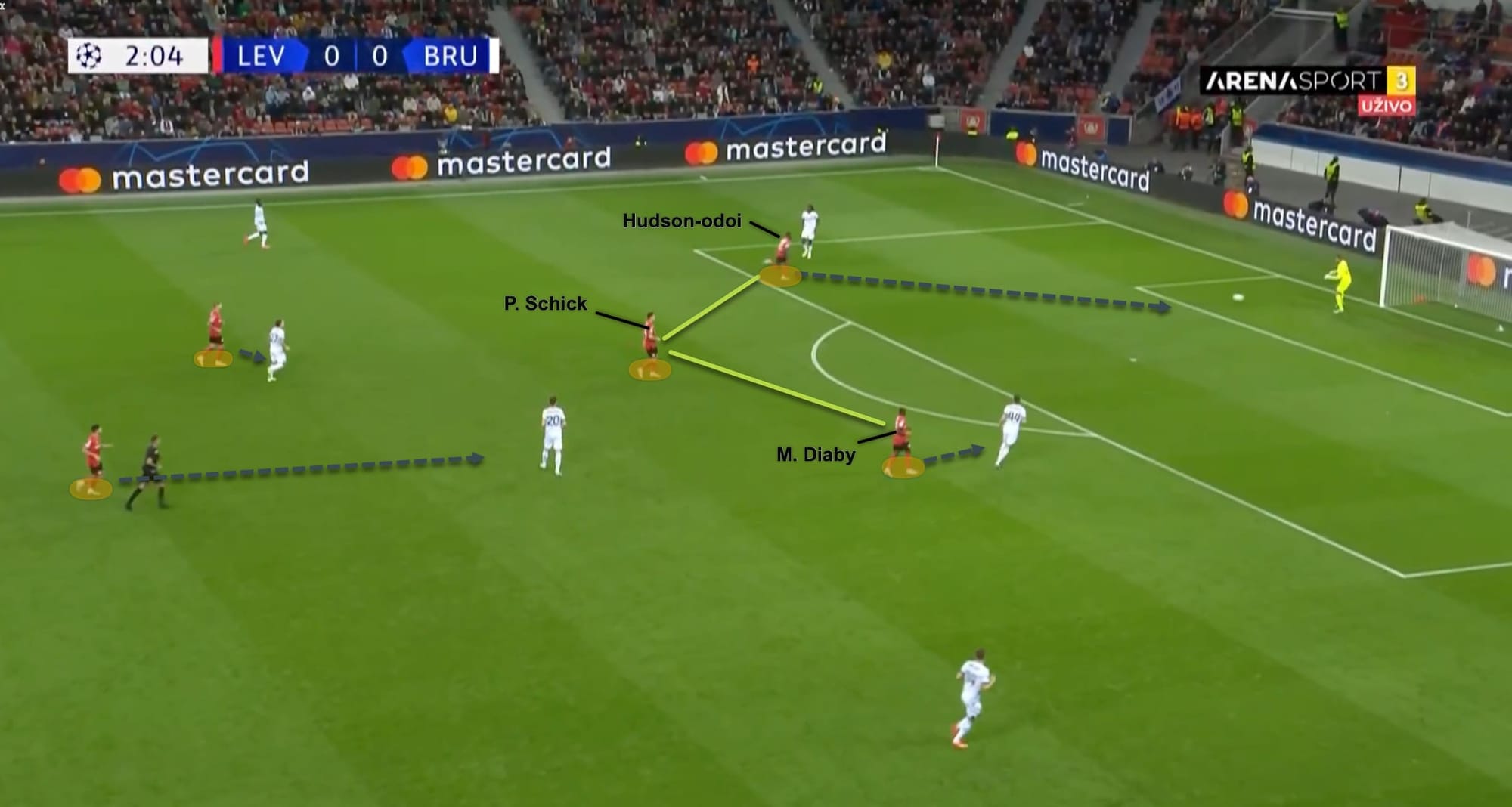
One of the essential components of Alonso’s strategy is pressing. He favours playing aggressively while keeping a solid organization. In the image above, the two quickest players team up to press the goalie hard. As a centre-forward, Schick moves down to block the defensive midfielder’s passing option. To impose even more pressure, the midfielder stepped up high.
In the case below, the defensive midfielders are given more room since Schick himself covered the defensive midfielder. This is accomplished by Hložek excellently.
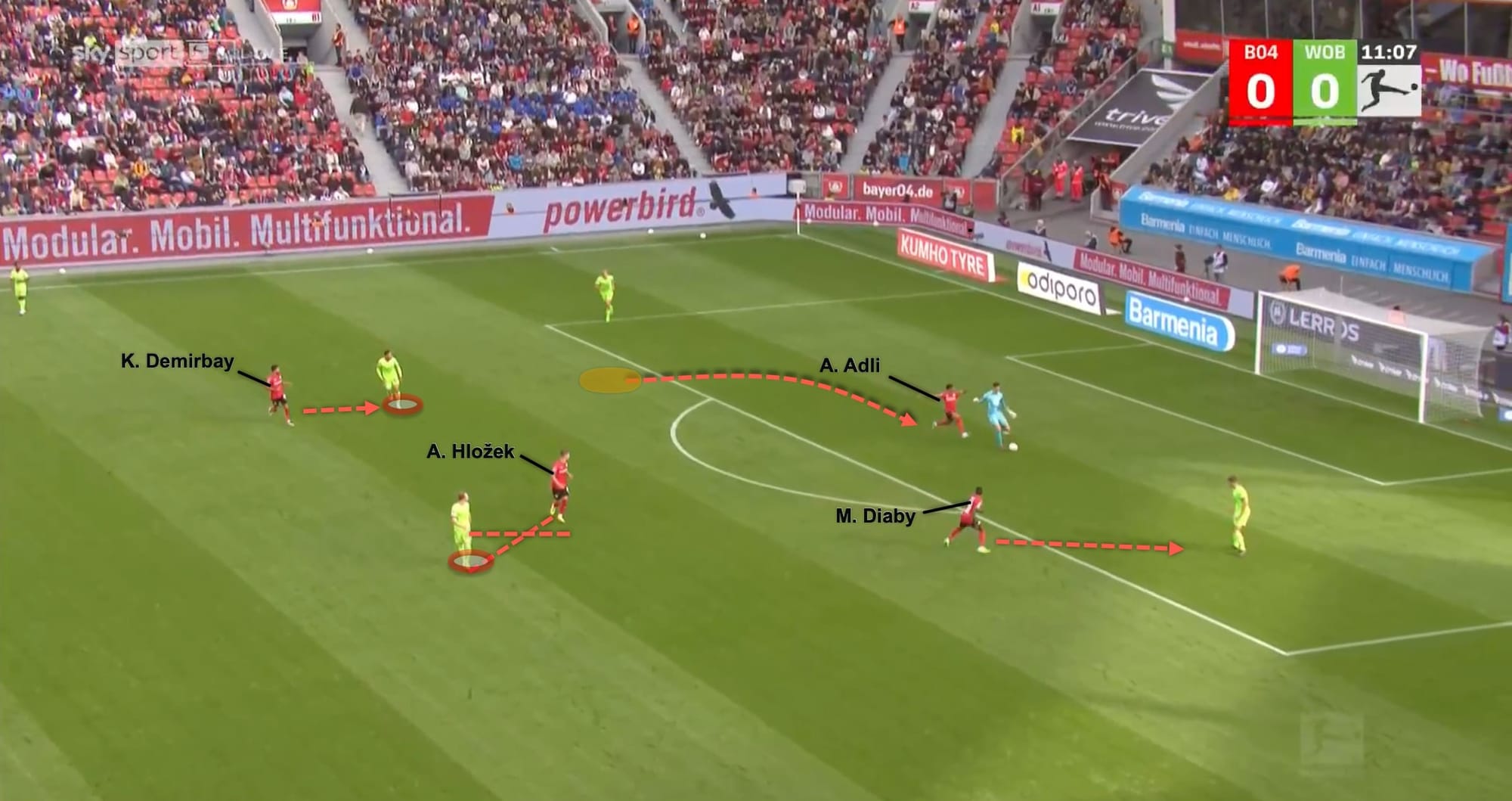
This energy around the team results to be maintaining a good atmosphere around BayArena. Alonso has become comfortable using this formation with his ideal set of players.
Key Players
We look at the key players who provide the most for Alonso’s plans and tactics. The future looks bright for him while Bayer Leverkusen, the team is filled with talented youngsters. This analysis will look into all the key aspects during his tenure at the club.
Moussa Diaby has been the team’s assassin thanks to his explosive speed and skill in front of the goal. Although he has a centre-forward personality, Alonso wants him to be positioned slightly behind the centre-forward to break through the defence. Despite his success this season, he was not chosen for the World Cup selection because of the star-studded team.
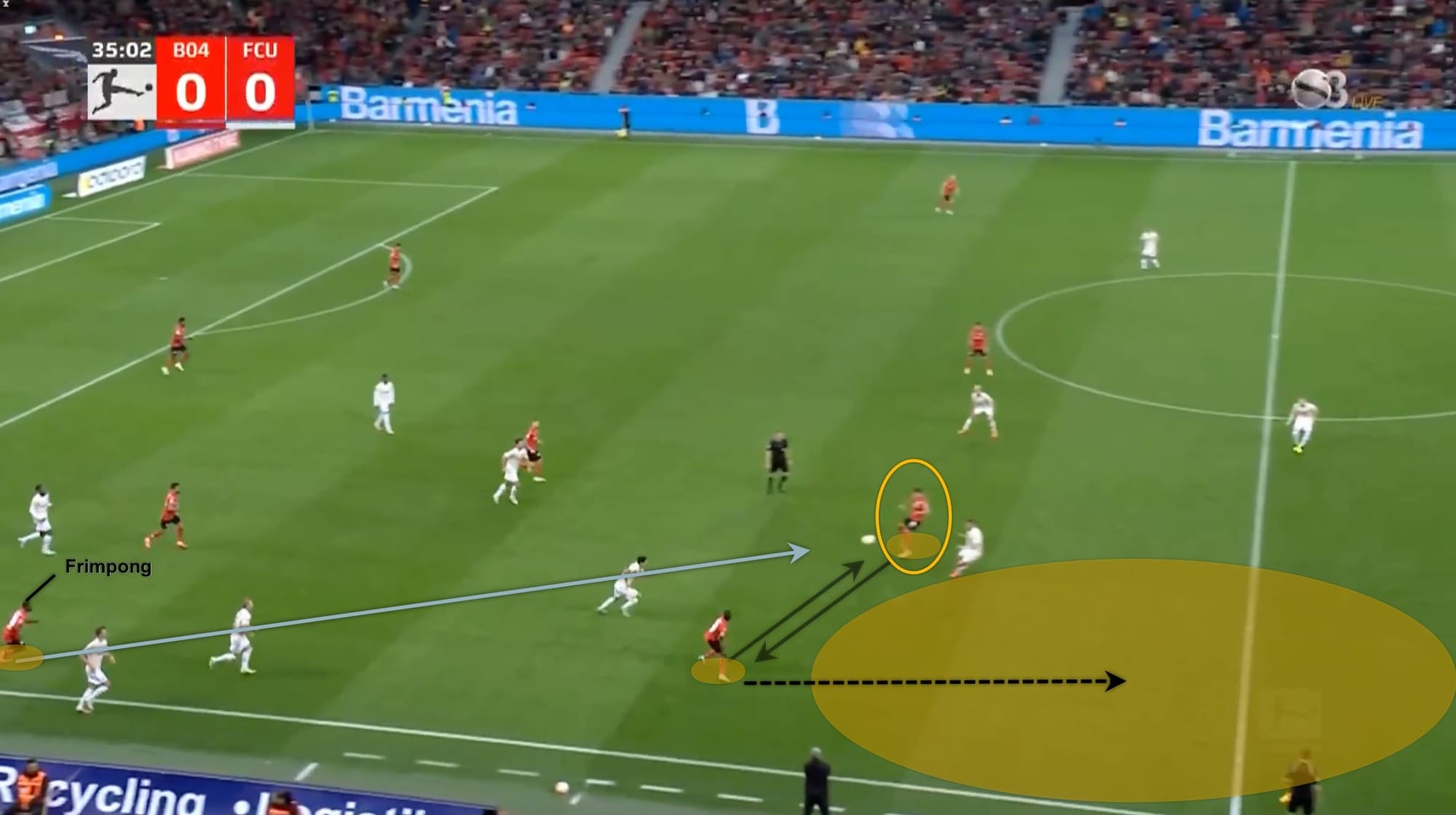
Leverkusen was put under pressure in the scenario shown in the graphic above. Hložek, who was excellently located by Frimpong in the centre, sends a first-time ball to Diaby. He then immediately passed back to Hložek to make a deep run. Diaby sped through the whole defence to deliver a crucial cross into the box that threatened to score.
The below graphic shows Diaby’s penetrating carries in the final third under Alonso. After playing him behind the centre-forward, he has quite a number according to statistics.
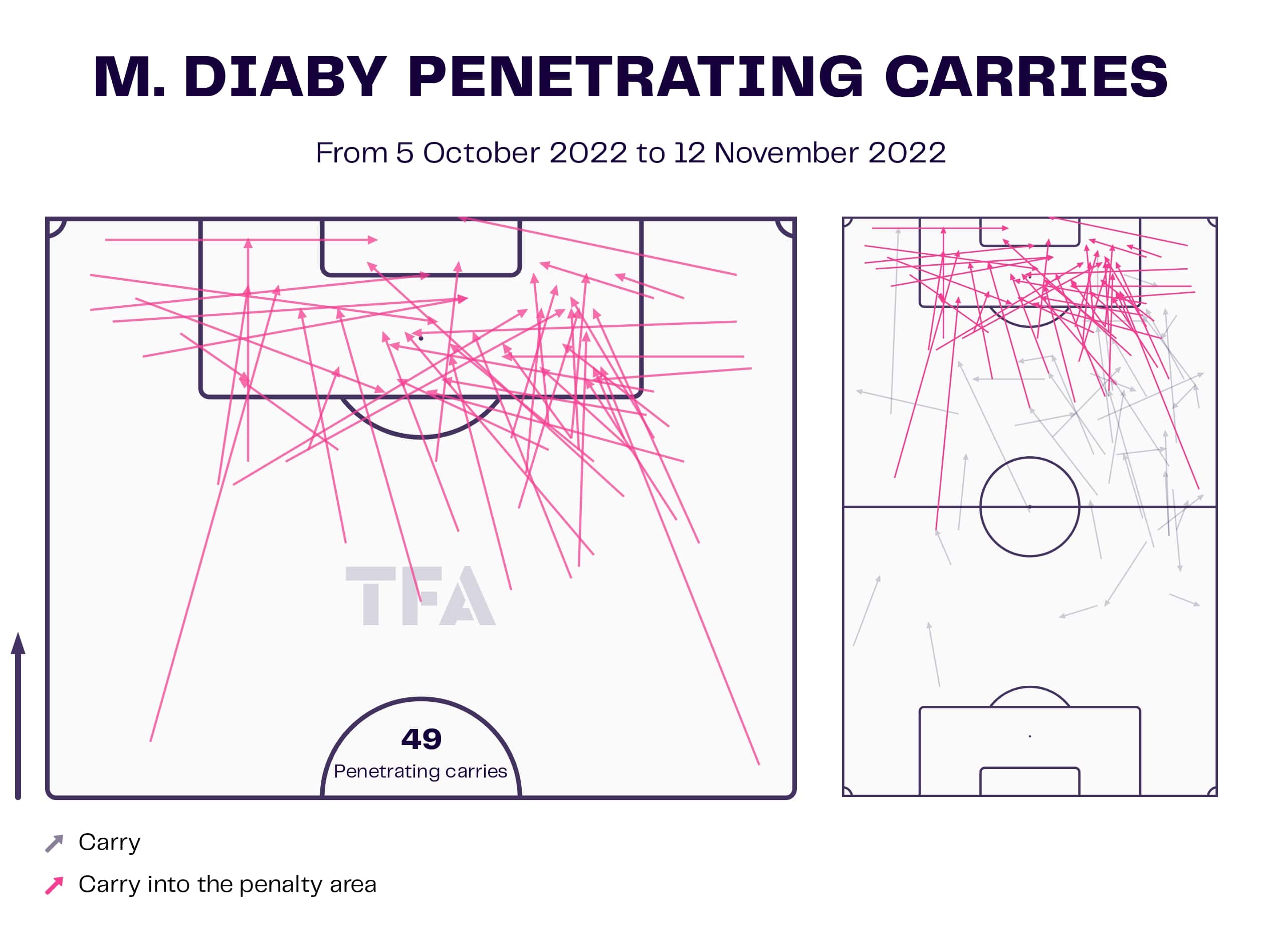
Robert Andrich had already established Alonso before he arrived. As a link between the defenders and the attacking midfielders, he takes an aggressive role in the centre. According to Alonso, he would develop into a ball-winning midfielder. It’s also turning out to be the right decision.
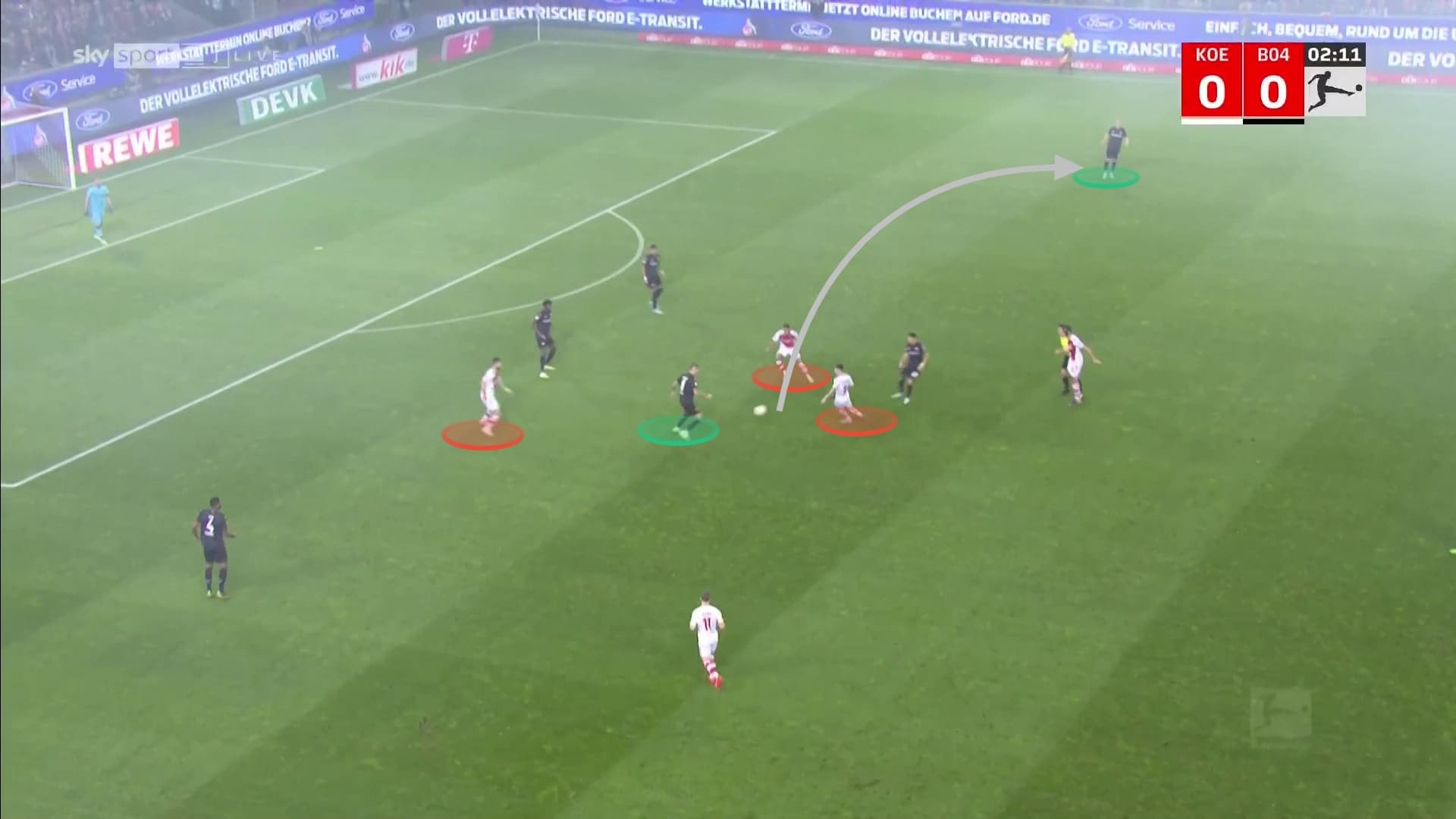
Due to his awareness, Andrich stands out in a crowd. He was the player that maintained the most calmness throughout the game. He seldom attacks from the front; instead, he often passes the ball to the attackers while standing slightly above the defence. Andrich can be seen in the above shot supporting the defence and creating space for Demirbay, who is attempting to move more often into the attacking midfielders’ zone.
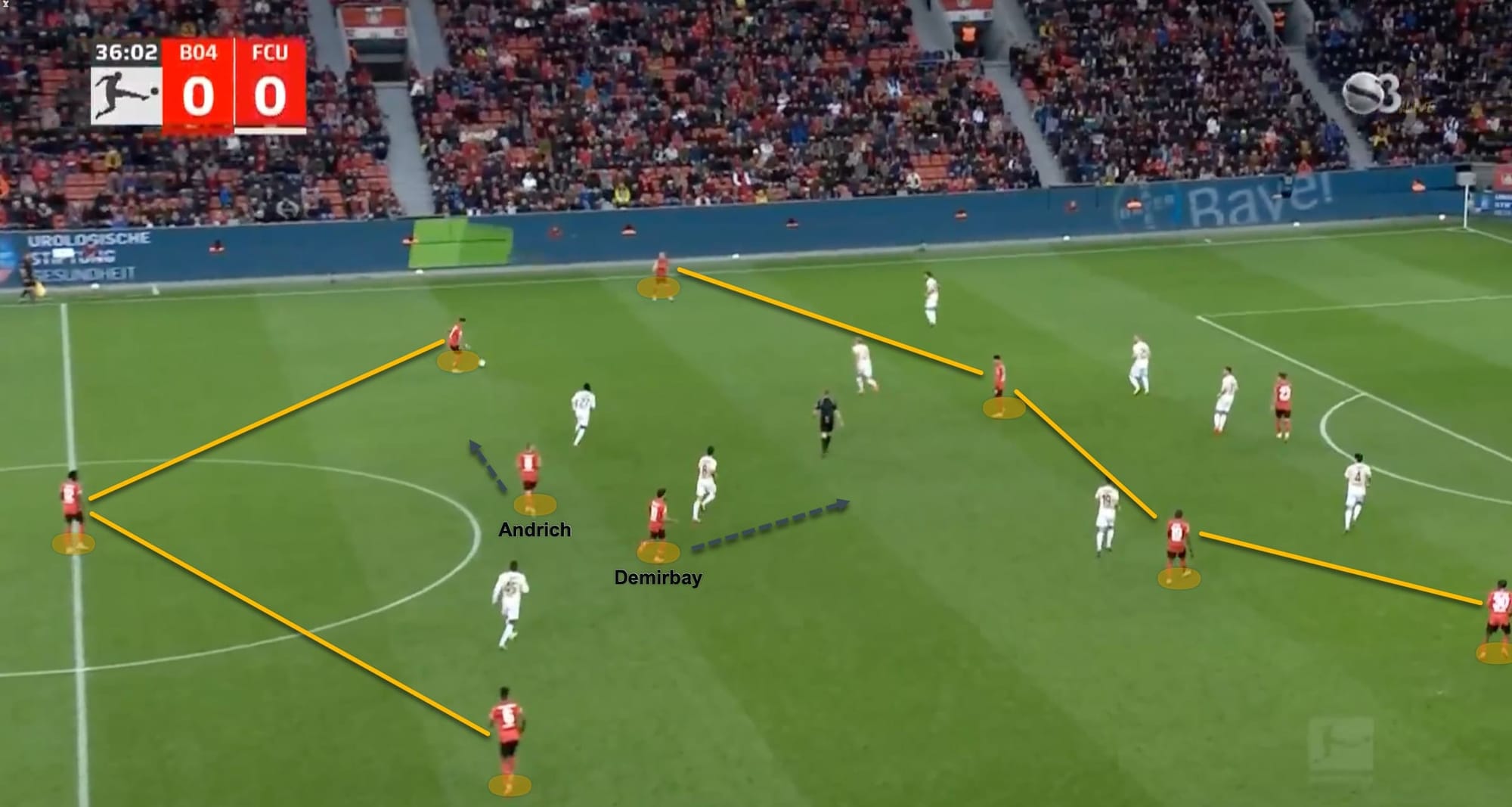
At critical moments, his first-time passes act as a means of escape. The above example is only one of them. Andrich is put in a small area with three opponents closing up on him. He calmly switches to Bakker to ease the pressure. Leverkusen benefits from getting vital information now while maintaining its composure.
Jeremie Frimpong, the Dutch national, has displayed excellent quality and is also consistent in his performances. After his performance this season, he had been called up to represent the Netherlands in the World Cup.
Below is one situation against Atletico Madrid in the Champions League. Frimpong combines with Diaby to bypass the defender. He then finds Hudson-Odoi who waits for the ball.
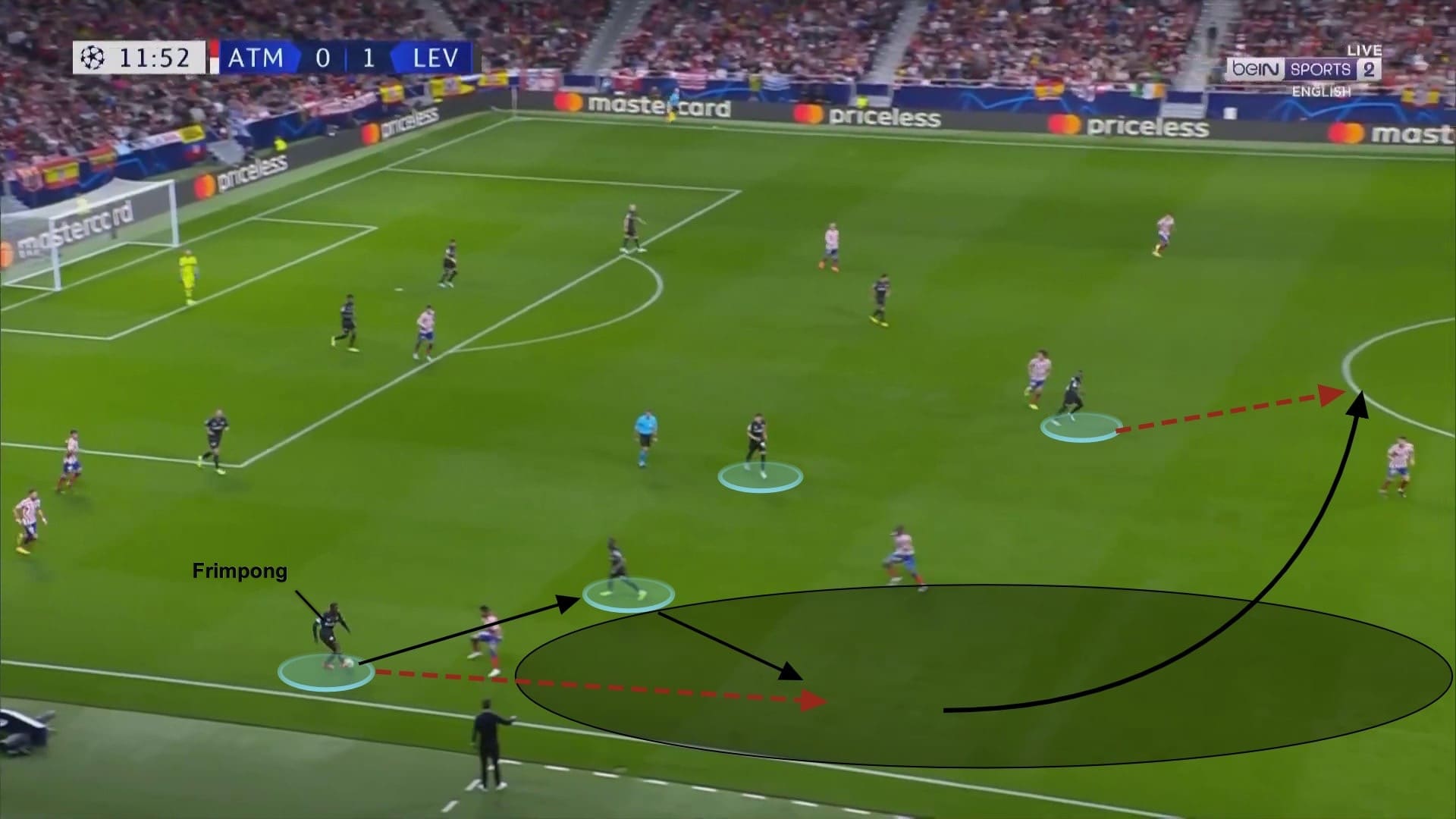
The agile full-back has been turned into a wing-back who combines with the attackers to create an overload. In a 3-4-3 structure, he has quite well settled in handling attacking situations. He has often combined with Diaby in the front to make wall passes to progress ahead.
Amine Adli, a left-footer, has featured 360 minutes in Alonso’s first nine games after being utilised rather often. This has given the 22-year-old a huge lift. On both sides, he has played as a winger/midfielder and sometimes as a centre-forward. Even though Adli has sometimes filled in for Diaby, Hudson-Odoi, and Palacios, he started games against prominent opponents like Porto, RB Leipzig, and Wolfsburg.
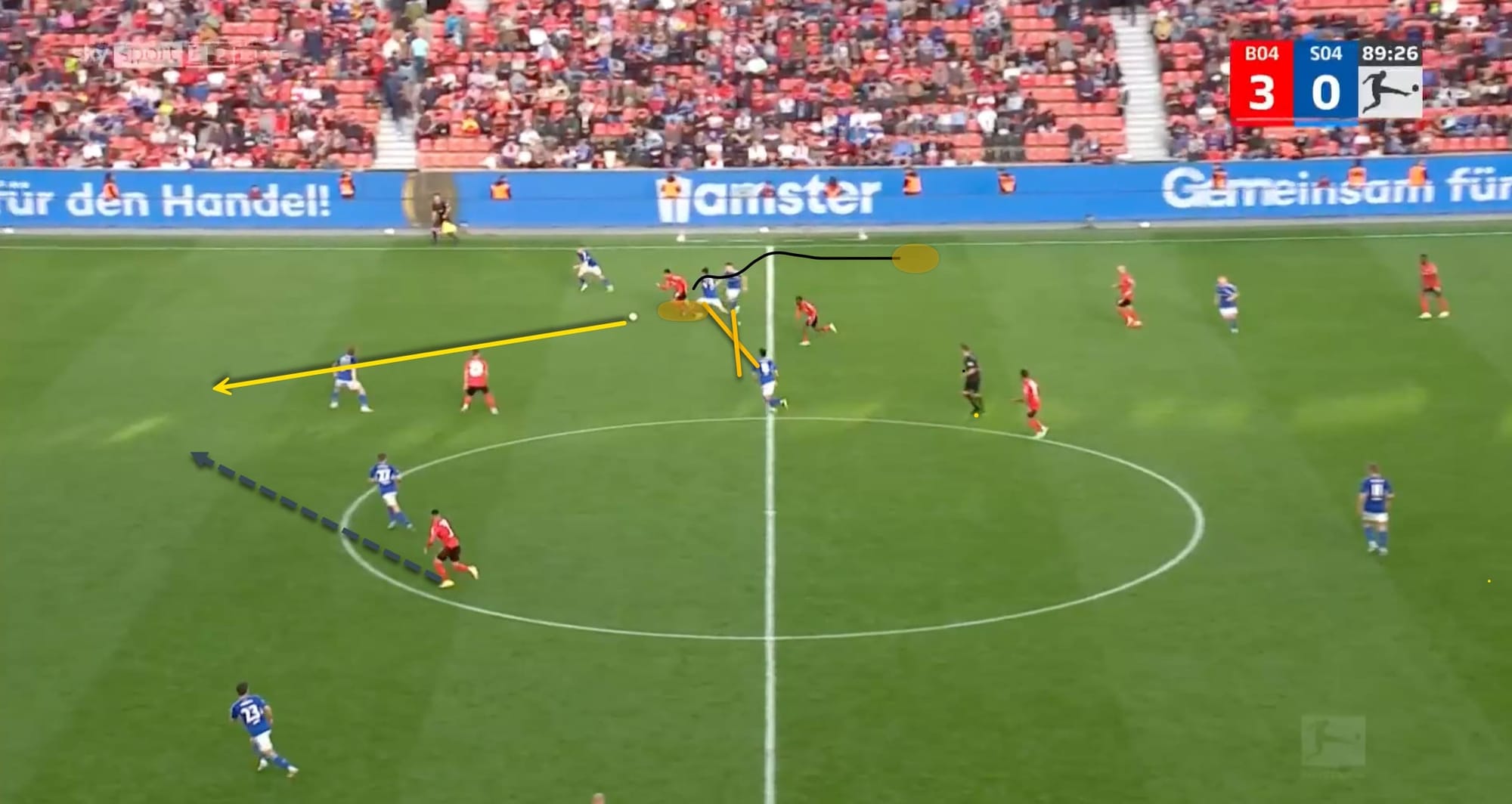
This shows the supporters that Alonso is willing to give the youngster a go. With his agility and close-control dribbling, he excels at outpacing opponents. Adli undoubtedly contributes a lot of enthusiasm to the team as the left-footed playmaker.
The image above shows Alonso’s first game. Adli wriggled through the opponent’s midfield to dismantle it. Adli, then deftly provided a through pass to Paulinho, who expertly slotted the ball into the bottom corner, after all, three midfielders had been dismissed. The fact that he is capable of making decisions on his own proves his value.
Conclusion
A ray of hope for the future is the inclusion of Florian Wirtz in the current squad. Supporters of Bayer Leverkusen will be thrilled by this exciting group. Alonso has played in 10 games for the Bundesliga, winning 4, drawing 3, and losing 3. The supporters of Bayer Leverkusen seem to be optimistic about the club’s future under him.
Jeremie Frimpong has pleased Louis van Gaal enough to be included in the World Cup squad. Piero Hincapié and Exequiel Palacios are the only other players representing Ecuador and Argentina in the tournament. Despite not appearing once under Alonso, Sardar Azmoun represents Iran in Qatar.
Alonso has a handful of individuals that he can mould to his liking. This may be a watershed moment in Leverkusen’s history if everything goes well. The main players highlighted in this analysis have the potential to become the next superstar at any point.

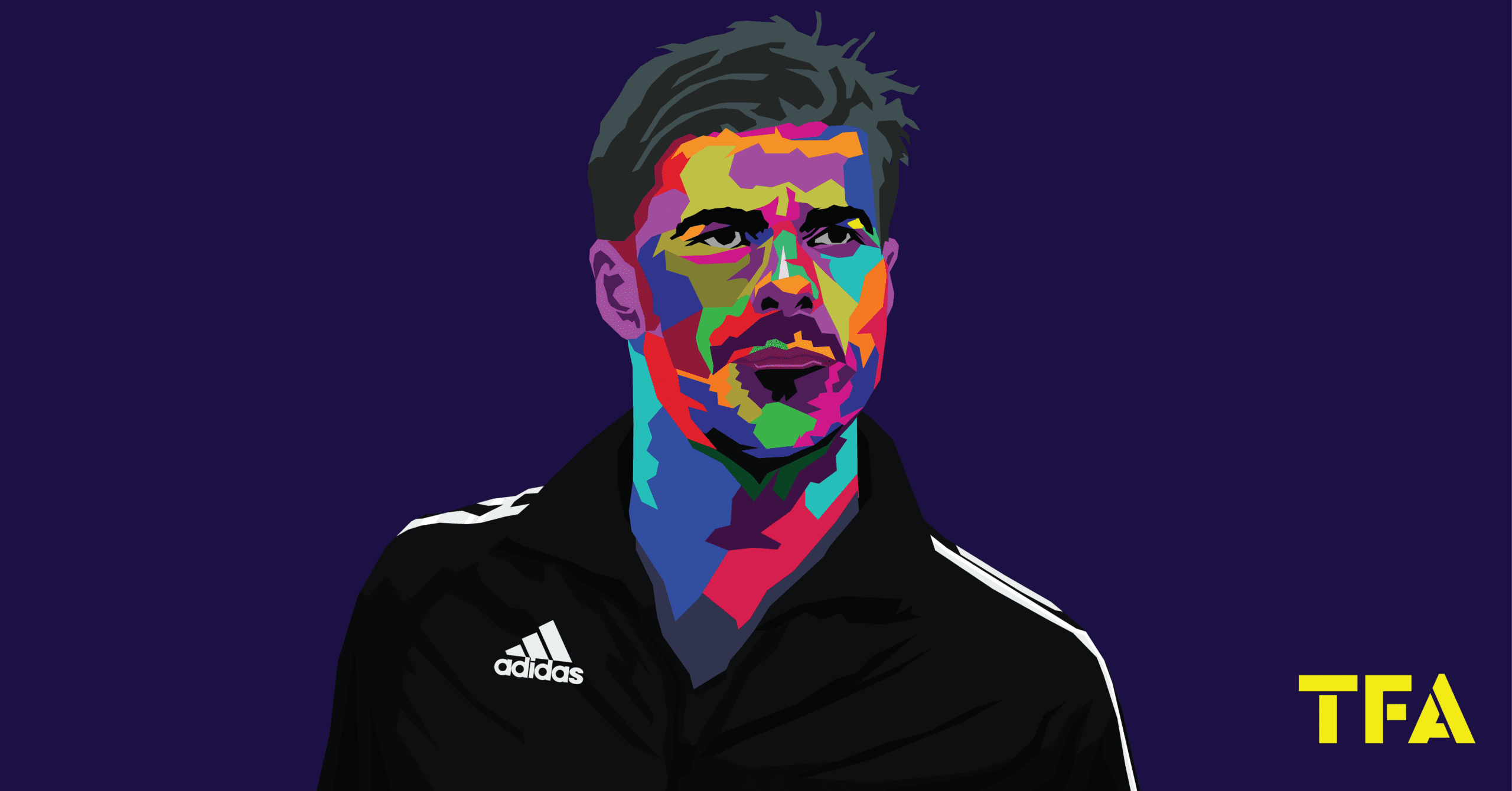



Comments